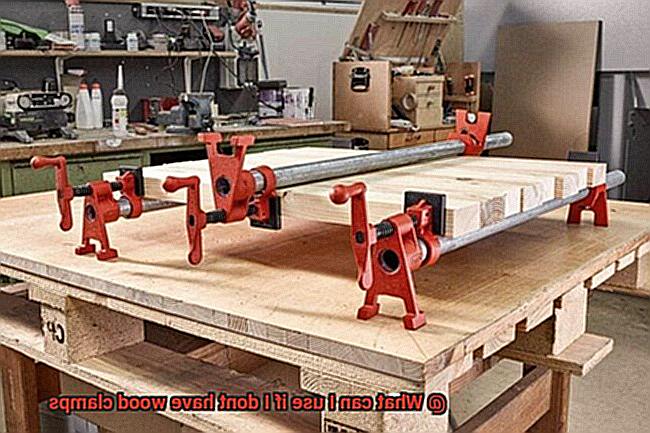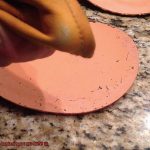Woodworking is an art that requires precision and accuracy, but not everyone has access to professional equipment like wood clamps. Fear not, my fellow woodworkers. There are several alternatives that you can use if you don’t have wood clamps at your disposal.
One of the most popular substitutes for wood clamps is using rope or twine. This method involves tightly wrapping the rope or twine around the joints you want to clamp together. Although it may not be as secure as a traditional clamp, it’s a cost-effective solution that works well for small projects.
Another option is to use spring clamps, which can be found at most hardware stores and are incredibly easy to use. They’re perfect for holding pieces of wood together while glue dries or when working with thin materials.
If you’re looking for something more heavy-duty, hand screws are an excellent alternative to wood clamps. You can purchase them online or from tool shops, and they work well for larger projects where you need a lot of pressure on the joints.
In this blog post, we’ll explore these alternatives in more detail so that you can achieve professional results without breaking the bank. Whether you’re a beginner or a seasoned pro, these tips will help take your woodworking game to the next level. So sit back, relax and keep reading.
What are Wood Clamps and Why Are They Important?
Contents
- 1 What are Wood Clamps and Why Are They Important?
- 2 Alternative Clamping Methods: Rope and String
- 3 Alternative Clamping Methods: Heavy Books or Weights
- 4 Alternative Clamping Methods: Tape
- 5 Alternative Clamping Methods: PVC Pipe Clamps
- 6 Benefits of Using Alternatives to Wood Clamps
- 7 Tips for Using Alternatives to Wood Clamps
- 8 Conclusion
Woodworking is a craft that requires precision, skill, and the right tools. One tool that is essential for any woodworking project is the wood clamp. These clamps are designed to hold pieces of wood together tightly while the glue sets, creating a strong and durable bond.

There are many different types of wood clamps available, each with its own unique advantages and disadvantages. C-clamps, F-clamps, bar clamps, pipe clamps, and more can all be used to apply pressure to the wood and ensure an even distribution of glue. From small joints to entire tabletops, woodworkers rely on clamps to hold their projects together.
Using wood clamps is important because they help achieve a tight fit between two pieces of wood. This creates a strong joint that will withstand wear and tear over time. Without clamps, gaps may form between the pieces being glued together, weakening the joint and leading to future problems.
In addition to holding pieces of wood together during the gluing process, clamps can also be used to keep wood in place while cutting or drilling. This helps prevent accidents by keeping hands away from the cutting area and ensures precision in cuts or holes.
Investing in a good set of wood clamps is crucial for success in woodworking. While they can be expensive, there are alternatives such as rope or string, heavy books or weights, tape, or even PVC pipe clamps that can be used in their absence.
Alternative Clamping Methods: Rope and String
You can use household items like rope or string as an alternative clamping method.
Using rope or string to clamp two pieces of wood together is a straightforward process. First, cut the pieces of wood to the desired size. Then, apply glue to one surface and place the other piece on top.
Next, wrap the rope or string tightly around the woods, making sure that they are held together firmly. Finally, tie the ends securely and let the glue dry. Voila. You have a sturdy joint.
One advantage of using rope or string is their versatility. They can be used to clamp irregularly shaped objects and larger pieces of wood that traditional clamps can’t handle. They are also an excellent alternative when you’re on a budget or don’t have access to conventional clamps.
However, there are some disadvantages to using rope or string as clamping methods. One is that they may leave marks on the wood surface, which may require additional sanding or finishing. Additionally, they may loosen over time, so it’s essential to check on the joint regularly.
Finally, it’s crucial to make sure that the rope or string you use is strong enough to hold up against the weight of the woods being clamped together.
Alternative Clamping Methods: Heavy Books or Weights
Don’t worry, you can still achieve a strong bond with an alternative clamping method – using heavy books or weights. This method is especially useful for smaller projects, where traditional clamps may be too large or unnecessary.
To use this method, apply glue to the joint and fit the pieces together.
Once they’re in place, evenly distribute heavy books or weights on top of the joint to apply pressure. This will help create a strong bond between the pieces of wood.
But before you go stacking every book in your collection on top of your project, keep these tips in mind. First, make sure that the weight of the books or weights is proportional to the size of the joint. For larger joints or heavier wood pieces, heavier weights may be needed.
Secondly, always use protective padding between the books or weights and the wood surface to prevent any damage or marks. The last thing you want is to ruin your hard work with scratches or dents.
Although heavy books or weights may not provide as much pressure as traditional clamps, they can still be effective for smaller woodworking projects. They’re also more affordable and accessible for those who may not have access to traditional clamps.
Alternative Clamping Methods: Tape
Tape can be a cost-effective and versatile alternative to traditional clamps. With various types of tape available, let’s delve into the world of alternative clamping methods and explore the advantages and disadvantages of tape.
First up, we have masking tape. This type of tape is easy to apply and remove, does not leave residue, and does not damage the wood surface. However, it may not provide enough pressure to hold large or heavy pieces of wood together. So, if you’re working with small or lightweight projects, masking tape could be a great option for you.
Painter’s tape, on the other hand, is a stronger adhesive tape that comes off cleanly without leaving residue. Additionally, it is wider than masking tape, providing more surface area for holding pieces of wood together. Painter’s tape is an excellent option for larger pieces of wood that require more pressure.
If you’re looking for something stronger than painter’s tape but still want to avoid using traditional clamps, duct tape can be an option. However, this type of tape should be applied with caution due to its strong adhesive properties.
It could potentially leave residue on the wood surface or damage it when removed. Thus, duct tape should be used only for temporary clamping or for holding pieces of wood in place while waiting for the glue to dry.
When using tape as an alternative to wood clamps, make sure to apply enough pressure to hold the pieces of wood together firmly. Tight wrapping or multiple strips of tape can achieve this goal. Additionally, ensure that the surface of the wood is clean and free from dust or debris before applying the tape.
Alternative Clamping Methods: PVC Pipe Clamps
However, traditional wood clamps can be quite expensive and may not always be the best fit for your specific needs. Thankfully, PVC pipe clamps offer a cost-effective and versatile alternative.
One of the most significant benefits of using PVC pipe clamps is their ability to be customized to fit any size or shape of wood. By cutting the pipes into different lengths and diameters, you can create clamps that are perfect for your specific project, saving you time and money in the long run.
Another advantage of PVC pipe clamps is their lightweight construction, making them incredibly easy to handle. This feature comes in handy when working on projects alone or when multiple clamps are required to hold different pieces together.
However, it’s important to note that PVC pipe clamps may not be suitable for all types of wood glue. Some stronger glues may require heavier pressure than what PVC pipe clamps can provide. Additionally, you must be careful when tightening the clamps as too much pressure can cause the PVC pipes to crack or break.
If you’re looking for a reliable and affordable alternative to traditional wood clamps, then PVC pipe clamps are an excellent option to consider. Here are some other benefits of using PVC pipe clamps:
- PVC pipe clamps are versatile and can be used for a wide range of woodworking projects.
- They are incredibly easy to make with just a few simple cuts to the PVC pipe.
- PVC pipes are readily available at most hardware stores, making it easy to replenish your supplies.
- They are resistant to moisture and corrosion, making them an ideal choice for outdoor projects.
Benefits of Using Alternatives to Wood Clamps
Not only can it save you money, but it also provides greater flexibility and expands your range of materials and techniques.
First off, the cost savings of alternative methods cannot be overstated. Traditional wood clamps are a necessary tool, but they can also be quite expensive. By using alternatives such as PVC pipe clamps or wedges and straps, you can reduce your costs without sacrificing quality. This makes woodworking accessible to hobbyists and professionals alike.
But cost isn’t the only benefit of using alternatives to wood clamps. These methods also provide greater customization and flexibility in your projects. Traditional clamps are limited in size and shape, making it difficult to work with larger or irregularly shaped pieces of wood. However, using alternative methods like heavy objects such as rocks or sandbags, allows for greater flexibility in your project.
Furthermore, alternative methods allow you to work with materials other than wood. Traditional clamps are designed primarily for use on wooden materials, but other materials such as metal or plastic may require different tools or techniques. By utilizing alternative methods, you can expand your range of materials and techniques in your woodworking projects.
Tips for Using Alternatives to Wood Clamps
Woodworking projects require clamps to hold pieces of wood together while the glue dries. However, not everyone has access to wood clamps or enough of them for their project. Luckily, there are several alternatives that can be used in their place. Here are five options to consider:
Spring Clamps
These easy-to-use tools come in various sizes and can be found at hardware stores. They apply pressure through a spring mechanism and are ideal for smaller projects.
C-Clamps
These clamps are commonly found in workshops and can hold larger pieces of wood together securely. They work by tightening a screw to apply pressure to the wood.
Clothespins
Don’t underestimate the power of these small and easy-to-use tools. Clothespins can hold smaller pieces of wood together temporarily or for small projects.
Rope or Twine
For larger projects, rope or twine can be used instead of clamps. Wrap it tightly around the pieces of wood and tie a knot to secure it in place. Be sure to apply pressure evenly across the surface area.
Weighted Objects
Heavy objects like books or bricks can also be used as a substitute for clamps. Place them on top of the glued pieces of wood and let them sit until the glue dries.
LLQa_koALNA” >
Conclusion
In the world of woodworking, precision and accuracy are essential. However, not everyone has access to professional equipment like wood clamps. But don’t let that stop you from pursuing your passion. There are numerous alternatives available that can help achieve professional results without breaking the bank.
From using rope or twine to heavy books or weights, tape, or even PVC pipe clamps, these alternatives can be just as effective as traditional wood clamps. They allow you to achieve a tight fit between two pieces of wood, creating a strong joint that will withstand wear and tear over time.
It’s important to note that investing in a good set of wood clamps is crucial for success in woodworking. While they may be costly, they are worth it in the long run. However, if you’re just starting out or on a tight budget, alternative methods such as PVC pipe clamps or wedges and straps can be used in their absence.
Not only do these alternative methods save you money, but they also allow you to work with materials other than wood. This opens up new possibilities for creativity and experimentation.
In summary, whether you’re a beginner or a seasoned pro, there are numerous options available when it comes to clamping materials together. By trying out these alternative methods such as using ropes or twines or even heavy books and weights, you can take your woodworking game to the next level without sacrificing quality.






